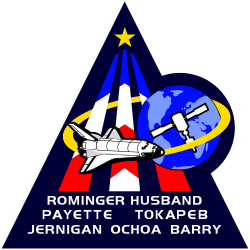Tamara E. Jernigan
| Tamara Elizabeth "Tammy" Jernigan | |
 | |
| NASA-astronaut | |
|---|---|
| Född | 7 maj 1959 Chattanooga, Tennessee |
| Tid i rymden | 63 dagar, 1 timme, 24 minuter |
| Urvalsgrupp | Astronautgrupp 11 |
| Antal rymdpromenader | 1 st |
| Rymdpromenadtid | 7 timmar, 55 minuter |
| Uppdrag | STS-40, STS-52, STS-67, STS-80, STS-96 |
| Uppdragsemblem | |
Tamara Elizabeth "Tammy" Jernigan, född 7 maj 1959 i Chattanooga, Tennessee, är en amerikansk astronaut uttagen i astronautgrupp 11 den 4 juni 1985. Hon är gift med den tidigare astronauten Peter Wisoff.
Rymdfärder
Källor
- ”Biographical Data” (på engelska) (PDF). NASA. november 2001. https://www.nasa.gov/wp-content/uploads/2016/01/jernigan_tamara.pdf?emrc=f6f41b. Läst 4 maj 2024.
Media som används på denna webbplats
Astronaut Tamara E. Jernigan in an Extravehicular Mobility Unit (EMU) spacesuit
This mission patch for mission STS-80 depicts the Space Shuttle Columbia and the two research satellites its crew deployed into the blue field of space. The uppermost satellite is the Orbiting Retrievable Far and Extreme Ultraviolet Spectrograph-Shuttle Pallet Satellite (ORFEUS-SPAS), a telescope aimed at unraveling the life cycles of stars and understanding the gases that drift between them. The lower satellite is the Wake Shield Facility (WSF), flying for the third time. It will use the vacuum of space to create advanced semiconductors for the nation's electronics industry. ORFEUS and WSF are joined by the symbol of the Astronaut Corps, representing the human contribution to scientific progress in space. The two bright blue stars represent the mission's Extravehicular Activities (EVA), final rehearsals for techniques and tools to be used in assembly of the International Space Station (ISS). Surrounding Columbia is a constellation of 16 stars, one for each day of the mission, representing the stellar talents of the ground and flight teams that share the goal of expanding knowledge through a permanent human presence in space.
STS-52 Columbia, Orbiter Vehicle (OV) 102, crew insignia (logo), the Official insignia of the NASA STS-52 mission, features a large gold star to symbolize the crew's mission on the frontiers of space. A gold star is often used to symbolize the frontier period of the American West. The red star in the shape of the Greek letter lambda represents both the laser measurements to be taken from the Laser Geodynamic Satellite (LAGEOS II) and the Lambda Point Experiment, which is part of the United States Microgravity Payload (USMP-1). The LAGEOS II is a joint Italian \ United States (U.S.) satellite project intended to further our understanding of global plate tectonics. The USMP-1 is a microgravity facility which has French and U.S. experiments designed to test the theory of cooperative phase transitions and to study the solid\liquid interface of a metallic alloy in the low gravity environment. The remote manipulator system (RMS) arm and maple leaf are emblematic of the Canadian payload specialist Steven MacLean.
STS-40 Mission Insignia
Designed by the crew members, this is the mission insignia for the STS-96 space flight, the second Space Shuttle mission dedicated to the assembly of the International Space Station (ISS). The crew patch highlights the major themes of the Station Program: Earth-directed research, the advancement of human space exploration, and international cooperation. The Space Shuttle Discovery is depicted shortly after reaching orbit as the crew prepares to carry out the first docking with the new Station. At this early stage in its construction, ISS consists of two modules: Zarya and Unity, shown orbiting Earth. The triangular shape of the patch represents building on the knowledge and experience of earlier missions, while the three vertical bars of the astronaut emblem point toward future human endeavors in space. The five-pointed star that tops the astronaut emblem in this depiction is symbolic of the five space agencies participating in the development of ISS: NASA, the Russian Space Agency, the European Space Agency, the National Space Development Agency of Japan, and the Canadian Space Agency. The blend of red, white, and blue is a tribute to the nationalities of the crew members who are from the United States, Canada, and Russia.
STS-67 Mission Insignia






